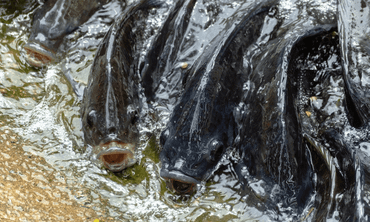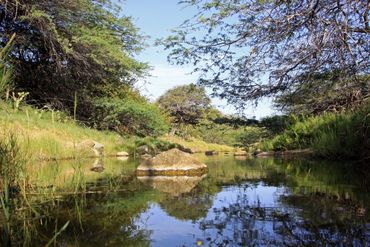
Tackling the Tilapia problem
Dutch Caribbean Nature Alliance (DCNA)Tilapia, a freshwater fish native to Africa, was introduced to Aruba, Curacao and St. Maarten, as part of aquaculture and fish stocking initiatives. The Tilapia were well adapted to this new environment and reproduced prolifically, leading to a significant population shift. A follow-on study conducted by CARMABI in 2000 found Tilapia to be one of the most frequently encountered species in freshwater habitats on Curacao. Similar results were seen on Aruba, where large numbers of these fish were found within the water basins of the natural springs of Fontein.
Ecological impact
 The introduction of Tilapia has had significant ecological consequences for these islands. One of the primary concerns is the competition for resources with native fish species. Tilapia is a prolific breeder with high reproductive rates, enabling them to outcompete native fish for food and breeding sites. Their aggressive feeding behavior and ability to adapt to various habitats further exacerbate their impact on local ecosystems.
The introduction of Tilapia has had significant ecological consequences for these islands. One of the primary concerns is the competition for resources with native fish species. Tilapia is a prolific breeder with high reproductive rates, enabling them to outcompete native fish for food and breeding sites. Their aggressive feeding behavior and ability to adapt to various habitats further exacerbate their impact on local ecosystems.
Tilapia also alters aquatic habitats by modifying vegetation and water quality. They feed on aquatic plants, uprooting and consuming them, which can lead to the loss of vital habitat for native species. Additionally, their excessive nutrient input through excretion can disrupt the balance of nutrients in the water, potentially leading to algal blooms and oxygen depletion. Lastly, research suggests that Tilapia can directly damage coral reefs by grazing on algae-eating fish, disrupting the ecological balance.
St. Maarten has experienced a series of mass Tilapia die-offs, particularly in the Great Salt Pond. In 2013, 2015 and 2020, thousands of Tilapia were seen floating in the channel, likely due to a decrease in oxygen levels in the pond. This decrease in oxygen is likely the result of rising temperatures, minimal rainwater and an increase in salt concentration.
Management challenges
 Controlling and managing the invasive Tilapia population in the Dutch Caribbean presents numerous challenges. Firstly, the sheer adaptability and reproductive capacity of Tilapia make eradication efforts extremely difficult. Their ability to survive in diverse environments, including both fresh and brackish water, hampers traditional containment strategies.
Controlling and managing the invasive Tilapia population in the Dutch Caribbean presents numerous challenges. Firstly, the sheer adaptability and reproductive capacity of Tilapia make eradication efforts extremely difficult. Their ability to survive in diverse environments, including both fresh and brackish water, hampers traditional containment strategies.
The invasion of Tilapia in the Dutch Caribbean poses significant ecological challenges for the region's delicate ecosystems. Competition for resources, alteration of habitats, and potential damage to coral reefs are some of the ecological impacts associated with this invasive species. The complexity of managing Tilapia requires a collaborative approach involving local stakeholders, government agencies, and international organizations.
DCNA
The Dutch Caribbean Nature Alliance (DCNA) supports science communication and outreach in the Dutch Caribbean region by making nature-related scientific information more widely available through amongst others the Dutch Caribbean Biodiversity Database, DCNA’s news platform BioNews and the press. This article contains the results from several scientific studies but the studies themselves are not DCNA studies. No rights can be derived from the content. DCNA is not liable for the content and the (in) direct impacts resulting from publishing this article.
Text: Dutch Caribbean Nature Alliance (DCNA)
Pictures: Sirawich Rungsimanop; Diego Marquez
